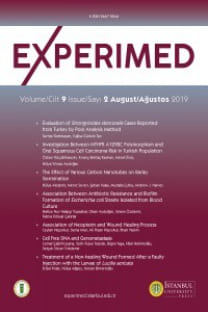Bir Olgu Nedeniyle Doğumsal Metabolik Hastalıklara Bağlı Parmak Ucunda Yürüme
DOI: 10.26650/experimed.2018.431791Parmak ucunda yürüme ve nöral tüp defektleri, genellikle nörolojik ve ortopedik olgu sunumları olarak yayınlarda sunulmaktadır. Altı yıllık poliklinik tecrübemiz nedeniyle parmak ucunda yürümede Metilen Tetra Hidro Folat Redüktaz (MTHFR) polimorfizmlerine dikkat çekmek için bu olgu seçildi. On yaşındaki kız hasta parmak ucunda yürüme ve hafif nörolojik gerilikle başvurdu. Aile öyküsünde anneannede inme dışında önemli bulgu yoktu. Öne çıkan klinik bulguları obezite, sakral gamze ve parmak ucunda yürümeydi. Laboratuvar değerlendirmesinde orta derecede lipid yüksekliği, MTHFR A1298C heterozigot mutasyonu görülmekteydi. Spinal manyetik rezonans görüntüleme (MRI) ile incelemede hipoplazik disk, spondilolistezis ve filar lipom tespit edildi. Klinik hasta izlemimiz sırasında 8000 hastanın 11 kız 9 erkek cinsiyette olan toplam 20 hastada parmak ucunda yürüme tespit edildi. Bunların hastalıklara göre dağılımı 3 geç tanı fenilketonüri (PKU), 2 metakromatik lökodistrofi (MLD), 1 L (OH) glutarik asidüri, 3 yağ aside oksidasyon bozukluğu (FAO), 1 mitokondriyal hastalık ve 10 MTHFR şeklindeydi. FAO grubunda ağrılı kas kramp atakları ve kas enzim artışları sırasında parmak ucunda yürüme gözlenmişti. PKU ve MLD’li hastalarda kalıcı nörolojik sorunlarla parmak ucunda yürüme ilişkisi görülmekteydi. Kısa Aşil tendonu L2 (OH) Glutarik asidüri hastası parmakucunda yürüme nedeniydi. MTHFR’li hastalarda nöral tüp defektleri ön plandaydı (1 sirengomiyeli, 1 filar lipom, 2 spondilolistezis ve 1 gergin kord). Erken döneminde parmak ucunda yürüme tanımlanan otizm etiolojisinde MTHFR de yer almaktadır. Hastalarımızdan birinde otizm tanısı vardı. Parmak ucunda yürüme sadece Aşil tendon ameliyatı ile düzeltilebilecek kadar basit bir sorun değildir. Altta yatan sorunun araştırılması gerekir.
Anahtar Kelimeler:
Parmak ucunda yürüme, kalıtsal metabolik hastalıklar, Otizm, MTHFR
Toe Walking Caused by Congenital Metabolic Diseases following a Specific Case
DOI: 10.26650/experimed.2018.431791According to the literature on cases of toe walking, neural tube defects generally refer to orthopedic and neurologic case reports. The case of toe walking has been selected to present the information obtained from our patient group monitored for 6 years and to draw attention to Methylene Tetra Hydro Folate Reductase (MTHFR) polymorphisms. A 10 year-old female patient has was applied for toe walking and mild neurologic retardation. Her family history was unremarkable, except for family history of stroke in her grandfather. Her prominent clinical findings were obesity, sacral dimple and toe walking. The laboratory assessment showed that moderately high lipid levels and MTHFR A1298C heterozygote mutation. A hypoplasic disc, spondylolisthesis and filar lipoma were detected in a spinal MRI. The final diagnoses of 20/8000 patients (11 female, 9 male) monitored in our clinic due to the symptoms of toe walking were as follows: 3 late diagnosed phenylketonuria (PKU), 2 metachromatic leuko-dystrophy (MLD), 1L (OH) glutaric aciduria, 3fatty acids oxidation defect (FAO), 1 mitochondrial disease and 10 MTHFR. A problem was detected in medium chain fatty acids in the patients with FAO. The complaint was considered to be muscle cramp due to increased muscle enzymes and aches throughout the complaint period. Considering neurological findings, the difficulties in walking were apparent in PKU and MLD patients. A short Achilles tendon was included in neurological findings in the patients diagnosed with L2 glutaric aciduria and mitochondrial diseases. From MTHFR patients, syringomyelia was found in one patient with sacral central line asymmetry and filar lipoma was detected in the remaining patients with deep sacral center lines whereas spondylolisthesis was observed in 2 patients and the presence of tethered cord was found in 1 patient. Toe walking refers to a finding defined as an early symptom of autism. MTHFR has been associated with autism. The autism like symptom was found only in one patient. The treatment of walking on the tip of the toe is not as simple as achieving success with local Achilles tendon surgery alone. It would be vital to find out the underlying cause.
Keywords:
Toe walking, congenital metabolic diseases, autism, MTHFR,
___
- Vavken, P., Kathleen, A., Ganal-Antonio, B., Shen, F.H., Chapman, J.R., Samartzis, D, 2015. Fundamentals of Clinical Outcomes Assessment for Spinal Disorders: Study Designs, Methodologies, and Analyses. Global Spine J . 5,156–164.
- Accardo, P.J., Monasterio, E.0, Oswald, D., 2014. Toe walking in autism. The Comprehensive Guide to Autism. New York: Springer; 519–532.
- Barrow, W.J., Jaworski, M., Accardo, P.J., 2011. Persistent Toe Walking in Autism. J Child Neurology, 26,5.
- O'Neill, B.R., Gallegos, D., Herron, A., Palmer, C., Stence, N.V., Hankinson, T.C., Wilkinson, C. C., Handler, M. H., 2017. Use of magnetic resonance imaging to detect occult spinal dysraphism in infants. Journal of Neurosurgery: Pediatrics, 19 , 217-26.
- Donmez, F.Y., Basaran,C., Ulu, E.M., Guvenc, Z., Tarhan, N.C., 2008. Unusual association of tethered cord, filum terminale lipoma, and myxopapillary ependymoma. Spine . 22,E849-51.Souweidane, M.M., Drake, J.M., 1998. Retethering of sectioned fibrolipomatous filum terminales: report of two cases. Neurosurgery. 42(6),1390-3.
- Kucera, J. N., Coley, I., O’Hara, S. et al.,2015. The simple sacral dimple: Diagnostic yield of ultrasound in neonates. Pediatr Radiol. 45, 211.
- Williams, C.M., Tinley, P., Curtin, M.,2012 . Vibration perception thresholds in children with idiopathic toe walking gait. J Child Neurol. 27,1017–1021.
- Stone, J.J., Rozzelle, C.J., 2010. Retethering of sectioned fibrolipomatous filum terminale in an adult: case report and review of the literatüre. The Spine J. 10,e1–e4.
- Yayın Aralığı: Yılda 3 Sayı
- Başlangıç: 2011
- Yayıncı: İstanbul Üniversitesi
Sayıdaki Diğer Makaleler
Ağır Malnutrisyon Nadir Bir Sebebi Olarak Smith Lemli Opitz Sendromu
Recai TÜRKOĞLU, Canan ULUSOY, Vuslat YILMAZ
Gülşen ALTINKANAT GELMEZ, Güner SÖYLETİR
Cihan COŞKUN, Alev KURAL, Macit KOLDAŞ
Fosfoproteomik Uygulama Basamaklarına Genel Bakış
Mustafa Gani SÜRMEN, Saime SÜRMEN, Sadrettin PENÇE
Bir Olgu Nedeniyle Doğumsal Metabolik Hastalıklara Bağlı Parmak Ucunda Yürüme
Tuncay GÜNDÜZ, Tuba TANYEL KİREMİTÇİ, Canan ULUSOY, Murat KÜRTÜNCÜ, Recai TÜRKOĞLU
